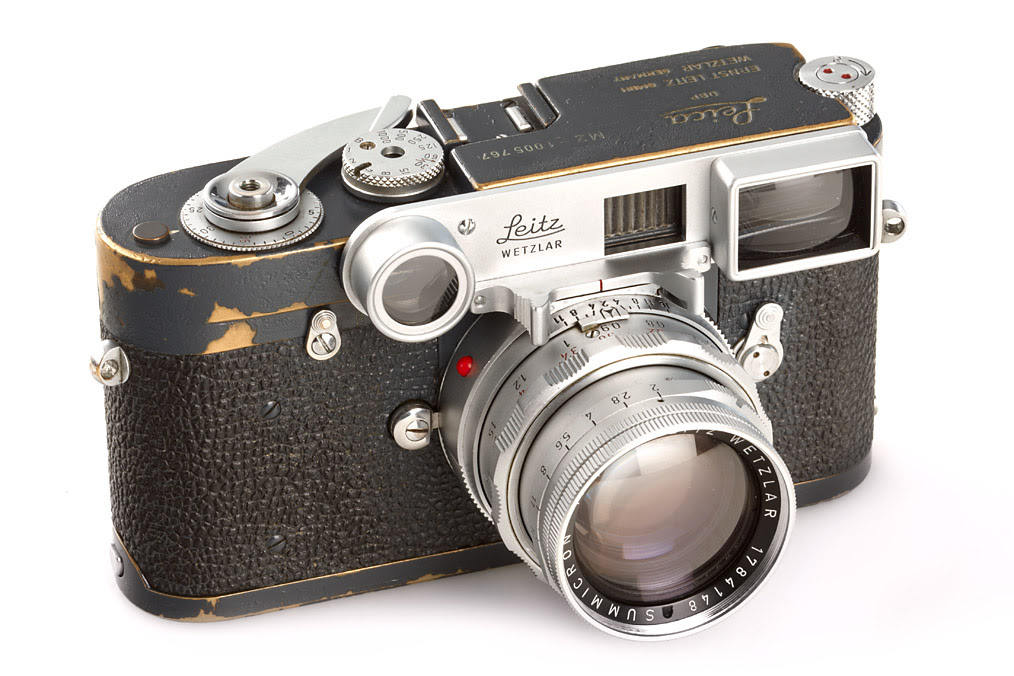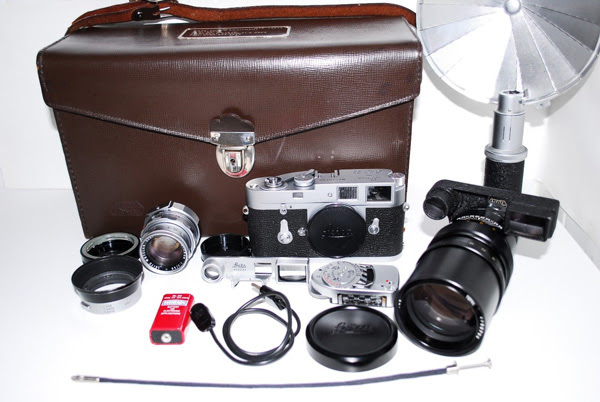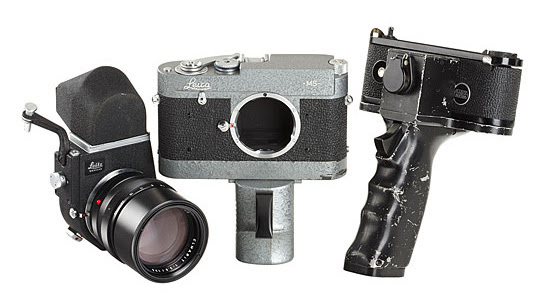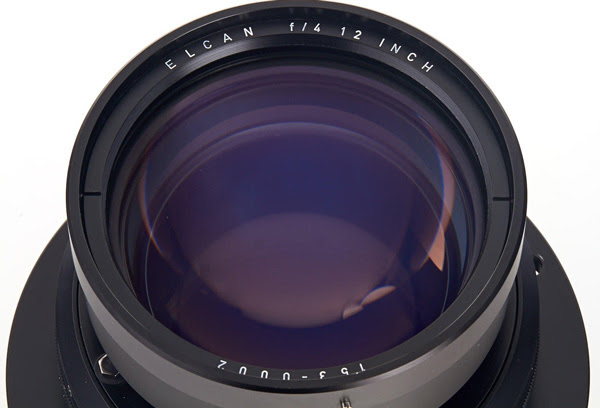
By Heinz Richter
NASA has to be considered to be at the very forefront of technological advances. Photography is definitely an important part of that. Thus it should come as no surprise that Leica equipment over the years has been chosen for a variety of missions.
An interesting, but relatively unknown fact is that NASA initially had chosen the Leica MDa as the camera to be used on their lunar missions. The reason was weight. Of all the systems for the Apollo missions, one could never be tested because of the low gravity of the moon. That was the lunar take-off module. To gain as much of a weight advantage as possible, NASA did everything they could to save weight. That included the camera equipment. The Leica MDa with 35mm f/1.4 Summilux was definitely lighter than anything Hasselblad, their regular camera of choice, had to offer. Leitz modified several cameras and lenses to feature large levers to allow camera operation with the bulky gloves of the space suits. The astronauts chosen for the lunar missions all received extensive training in the use of the camera.


NASA Leica MDa. Modifications appear to be a soft shutter release, a larger shutter speed dial, an enlarged film wind lever a large rewind knob and an enlarged lever to open the camera. The top of the camera also has a beefed up plate with an accessory show attached. There is also an electronic connection of an unknown purpose in place of the PC connection.
Modifications of the lens are large levers for the aperture and focus settings, all designed for easy operation with the gloves of the space suits.
Yet, as is common knowledge, the Leica never made it to the moon. The credit goes to one engineer who figured out that the interchangeable film backs for the Hasselblad were lighter than the Leica MDa with its Summilux lens. Subsequently NASA decided to use the Hasselblad after all. The Saturn 5 rockets had no problem delivering the payload to the moon. For the return trip it was subsequently decided to remove the film backs from the cameras and to leave the cameras and lenses on the moon where they still reside today. A total of 12 Hasselblad cameras and lenses are sitting in the lunar dust, ready to be picked up.
An intriguing question is if they might be still able to operate properly after all these years in the extremely harsh environment of the lunar surface.
Since then a few more details about the NASA – Leica connection have emerged. One virtually unknown fact is that NASA also used the Leicafelx SL. For what purpose is unknown at this point. I have also found that in 1966, NASA ordered 150 Leica cameras. Unfortunately it was not stated which cameras they were.

The camera appears to be without visible modifications other than the deeply knurled shutter speed dial to accommodate the heavy gloves of the space suits.
Already in the earliest stages of the NASA space program, Leica cameras were part of the equation. One such camera was the Leica Ig. With this camera astronaut John H. Glenn, Jr., took the first human-shot, color still photographs of the Earth during his three-orbit mission on February 20, 1962. Glenn's pictures paved the way for future Earth photography experiments on American human spaceflight missions.

Because Glenn was wearing a spacesuit, complete with helmet during his February 20, 1962 mission, he could not get his eye close to a built-in viewfinder. Therefore NASA selected the high-quality Leica Ig camera that allowed them to attach a customized viewfinder on top. This special attachment featured a suction cup on the back side to allow Glenn to easily place the device against the visor when he was required to keep it down. The viewfinder was removable when Glenn did not need his visor down, and a velcro strip on the rounded top let him manage its location inside the spacecraft. Glenn found the camera easy to use, in part because he could exploit the advantages of zero-gravity.
"When I needed both hands, I just let go of the camera and it floated there in front of me," he said in his later memoir.

The 1957 Leica Ig was the last Leica screwmount model made, with production ending in 1963. It was the successor to the If and is the only screwmount camera with the word 'Leica' engraved on the front of the camera. This camera had the same profile as the IIIg but without the viewfinder/rangefinder incorporated into the top. As with both the Ic and If there were two accessory shoes mounted for attaching a separate viewfinder and rangefinder. The rewind knob was partially recessed into the top plate. As with the Ic and the If, the Ig was intended for scientific or Visoflex use.
My continued research into Leica cameras that were used by NASA has yielded another interesting result. This Leica camera was used in conjunction with a spectrograph and was used on the Gemini V and VIII missions. Longer missions during the Gemini program gave astronauts more time for scientific experiments, often created and monitored by other government agencies or academic institutions. Scientists at the U.S. Weather Bureau (now NOAA) created this camera attachment so it could simultaneously record a spectrum and an infrared image to determine cloud heights.

The camera appears to be a model M3. It is unknown if any special modification were necessary for this specialized use.
However, NASA certainly is not the only branch of the US government that has used Leica equipment and a very important part of that was Ernst Leitz Canada, ELCAN under the initial leadership of Walter Kluck. He was joined by one of the greatest lens designers of the time, Dr. Walter Mandler.


Walter Kluck

Dr. Mandler and Otto Geier, supervisor of the Midland optical department
Besides the civilian market, ELC soon became heavily involved in manufacturing for the US Defense Department, primarily the US army but also the Navy which lead to the ELCAN HIGH RESOLUTION 35mm CAMERA SYSTEM. Already in the 1960s they were aked by the US Navy to develop a high resolution 35mm camera system. This was based on the Leicaflex SL.

Leicaflex SL with 75mm f/2 ELCAN Lens

Photos: James L. Lager, Leica Illustrated History, Vol. II, 1994, p. 307, 309 and Vol. III, 1998, p. 319

The chrome version of the Leicaflex SL was also used by the US Navy
Research had shown that optical glasses with anomalous properties could greatly improve the performance of photographic lenses. The first such glass was developed in the late 60s and early 70s by the glass research laboratory at Ernst Leitz Wetzlar. These glasses are commonly referred to as extra low dispersion or fluor crown glasses. They allow the easier design and manufacture of apochromatic lenses. Only true apochromats have the ability to focus all colors of the visible spectrum at one common point. Mr. Schantz further states:
A series of such apochromates has been designed and manufactured under contract by Ernst Leitz Canada Ltd (Elcan). The lenses were designed by Professor Dr. Walter Mandler. The lenses consist of: Elcan-R 75mm f/2, Elcan-R 180mm f/3.4, Elcan-R 450mm f/5.6 all of which were classified pieces of equipment.

ELCAN 75mm f/2
Photo: L Camera Forum

180mm f/3.4 Apo Telyt

Schematic of the 180mm f/3.4
Of those three lenses, the 180mm f.3.4 ELCAN lens proved to be the most practical one which resulted in a declassification, allowing Leitz to make the 180mm part of their lens line for the Leica reflex cameras. It entered the market in 1975 as the 180mm f/3.4 Apo Telyt R. Even today it ranks as one of the best lenses ever made for general photography.
One of the most unusual military developments was an underwater camera system which Leitz developed for the US Navy. It primarily consisted of a complete set of lenses for underwater work, not only for 35mm cameras but also for medium format, 16mm motion picture and TV cameras. These were rather unique lenses because they were not part of a camera that was simply put into a water tight housing. Instead the lenses were designed to be exposed to the water with their front element. When designing such lenses, Leitz even took the refractive index of air into consideration.

ELCAN under water housing for Leica M camreas, front view

Back view

Inside, front and back view with Leica M4 camera installeed



Today the system is on display, together with other military equipment
at the Leica Museum in Wetzlar

ELCAN under water housing for motion picture and video cameras

ELCAN under water lens system with water contact front lens element
This Leitz under water system was designed according to the refractive index of water. As a matter of fact, since this system was to be used primarily in salt water, it was the refractive index of salt water that was used in the design of these lenses. However, not all oceans have the same salinity. So Leitz went one step further and took the refractive index of the salinity of the various oceans into consideration. This was possible with an interchangeable front element of their water contact lenses. This overall design actually considers the water as an integral lens element of the entire system. To avoid the need to test these lenses in the various oceans all over the world, Leitz built a large water tank that could be flooded with water of the appropriate salinity.

Water salinity test tank
The correction of these lenses is so good that, when water is clear enough, there is no way of telling that the pictures were taken under water. Leitz was the first company to suggest such a design.
What is even more amazing is the fact that the thick water contact front element is so strong that the lenses can be used in the greatest ocean depths without any problems at all, including the deepest part on earth, the 36,200 feet deep Challenger Deep of the Mariana Trench.
A very rare version delivered to the American Armed Forces was the Leica IIIc K, order 3152 of July 7, 1945, just after the end of the war. At the time a highly sought-after machine, because it was the most advanced Leica camera, with almost exclusive military use. The “K” designated the camera as a special model, modified especially for use at very low temperatures. The “K” stood for the German word kältefest, cold resistant.


This model of the Leica IIIg was delivered to the US Navy.




The Leica KE-7A, or its exact designation: Camera Still Picture KE-7A is a special version of the M4, dating back to the early seventies, specially designed for the American Army, suitable for working perfectly even in extreme temperatures. It was usually supplied with the 4-lens Elcan 50mm f/2 lens, an faster version of the Leitz Emar f/2.8 lens, but it also was equipped with the rare Elcan 66mm f/2, a complex lens with very high resolution. The KE-7A was the only military Leica that has been available to the public in a limited number of 505 cameras. They were all deliverd with the 50mm f/2 Elcan.


Elcan 66mm f/2
Leica M2 Grau, was a ver rare version of the Leica M2. Only 20 of them were delivered to the US government in 1960.



The US Navy ordered a specil version of the Leica M2 as a complete set with the 50mm f/2 Duel Range Summicron and 135mm f/2.8 Elmarit.. The set also included a Leicameter and a variety of other accessories, including a carrying case. A number of 874 cameras of this version of the Leica M2 were later sold to the public as the Leica M2R.




The Leica MS was specially built in 1962 for the American Navy for reconnaissance at low altitude, during the Cuban missile crisis. It was used to photograph Soviet ships that carried missiles to Cuba. The camera is a Leica MD, made in Canada, modified with only 3 shutter speeds, 1 / 250-500-1000sec, in gray hammertone finish. The camera was equipped with a special back including a handle with a shutter release and a built-I motor drive. The camera came with a Visoflex III and a special Elmarit 135mm f / 2.8 with focus locked AT infinity. In some cases the camera had an extension tube instead of the Visoflex. A Summicron 90/2 was also available. Only 6 of this combination were ever made.




An unquantified number of the M4-MOT were made for the US Navy.


The Elcan 90mm f/1 was a very rare fast lens made for the US Navy. Only 10 copies were made. The lens had no rangefinder coupling. Instead it had three extension rings with a set focusing distance of 20, 50 and 100 meters. It is thought that the lens was used to photograph Russian submarines in low light, coupled with an infrared light beam.



One of the rarest lenses made by Leitz Canada was the Elcan 21mm f/4 used to photograph submarines from portholes. The lens was to be used with a Leica with M4-P body. Leitz stated that they obtained the same degree of optical correction as the optics for aerial photography, thanks to a patented system of a front dome, placed between the optics and the glass of the submarine.
Only 2 examples of this special lens are known.



In some cases Leitz Canada supplied lenses for cameras made by other manufacturers. One such camera was the KE28B Maurer, a special 6x6cm format camera for aerial shots during the Vietnam War. The camera was equipped with a 6 inch Leitz Canada lens (approx. 150mm) f / 2.8. Leitz Canada also designed a 12 inch (300mm) f/4 lens, complete with yellow filter. However, it never was made beyond the prototype stage.




Some of these lenses were also made for the British Vinten F95 camera for aerial reconnaissance, which normally used Taylor & Hobson lenses. They were used on the HS Harrier vertical take-off aircraft, widely used by the Royal Navy in 1982 in the Falkland-Malvinas war.
It is interesting to see that some of the Leica cameras and lenses which were specially developed for military use, were later declassified and made available for the civilian market. Of course all of these are very much sought after collectors items now.
For more on ELCAN, Leitz Canada go here.
For other articles on this blog please click on Blog Archive in the column to the right
To comment or to read comments please scroll past the ads below.
All ads present items of interest to Leica owners.
_______________________________________________________________________
For other articles on this blog please click on Blog Archive in the column to the right
To comment or to read comments please scroll past the ads below.
All ads present items of interest to Leica owners.
_______________________________________________________________________

Buy vintage Leica cameras from
America's premier Leica specialist

Buy vintage Leica cameras from
America's premier Leica specialist
Click on image to enlarge
Order: info@gmpphoto.com
Please make payment via PayPal to GMP Photography
Click on image to enlarge
Order: info@gmpphoto.com
Click on image to enlarge
Order: info@gmpphoto.com
Click on image to enlarge
Order: info@gmpphoto.com
Please make payment via PayPal to GMP Photography
Click on image to enlarge
Order: info@gmpphoto.com
Please make payment via PayPal to GMP Photography
Click on image to enlarge
Order: info@gmpphoto.com
Please make payment via PayPal to GMP Photography












No comments:
Post a Comment